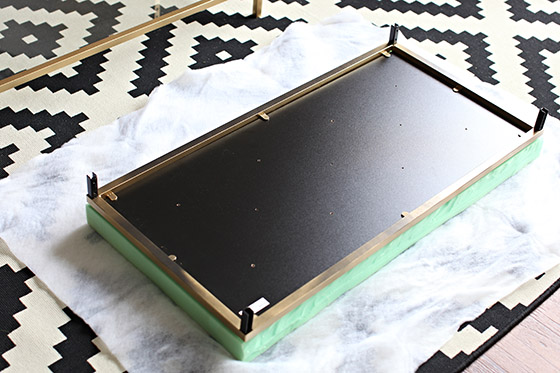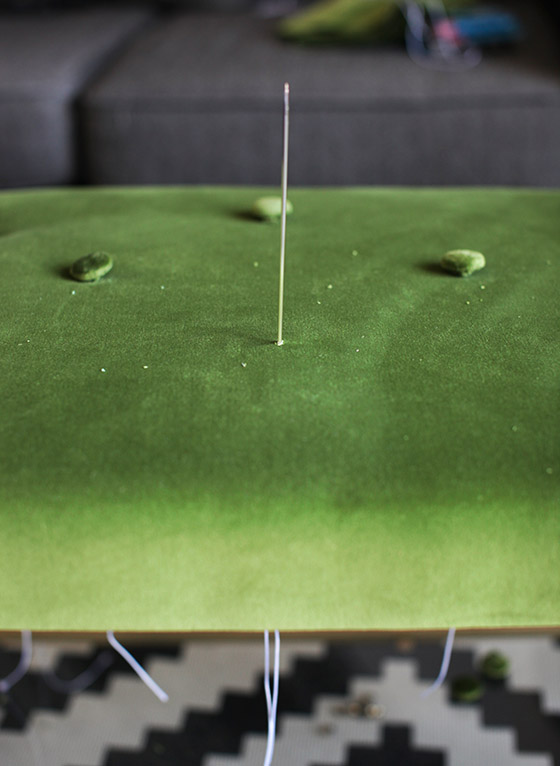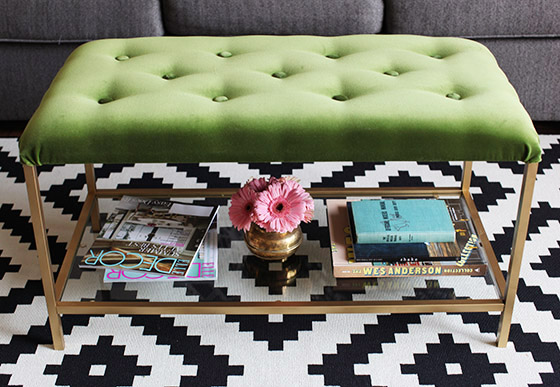I have this problem where I envision something that I want and either it doesn’t exist or the closest thing I can find costs, like, a million dollars and still isn’t exactly what I had my heart set on. I have another little problem where I see something generic in a store and immediately start planning how I could change it to fit my personal style and make it, well, less generic. This happens way more often than you’d think. I’m all “Blahblahblah we can paint it and then cut this off and then maybe screw these together…” My husband stares at me for awhile before voicing his concerns, which I usually just brush off, and reply with a casual “It’ll be fiiiiine.”
And that’s what happened this time. I wanted a cocktail ottoman to use as a table and footrest, in some great color, probably tufted, with a little gold to tie in with the rest of the room. Couldn’t find it. When I saw the surprisingly sturdy VITTSÖ nesting tables at IKEA I instantly knew how I was going to make it happen. I would just need to upholster…and paint…and drill a little. NO BIGGIE. No, seriously, it’s a lot easier than it sounds.

Finding the perfect fabric was actually the most annoying part. I went to 4 different fabric stores before I found the perfect green velvet at Deco Home for $80/yard. Totally worth it. It’s durable and lovely and perfect for a project like this. Exactly what I wanted.
ANYWAY, I’ll get down to it.
I put together the frame of the table and sprayed the entire thing with metallic gold spray paint. You can use whichever gold you like.
I sprayed all the hardware and those little glass cushion sticker things gold, too.
 I picked up one yard of 2″ thick foam from the craft store and cut it to the size of the table. Using a sharp knife or blade makes it super simple. Just run the blade through a couple of times. You should maybe put cardboard or something down so you don’t slice up your floor.
I picked up one yard of 2″ thick foam from the craft store and cut it to the size of the table. Using a sharp knife or blade makes it super simple. Just run the blade through a couple of times. You should maybe put cardboard or something down so you don’t slice up your floor.
The larger table in VITTSJÖ nesting tables set has a glass shelf on the top and a wood (MDF) shelf on the bottom, but since this is a hack, I switched them. Why? Because I needed to use the MDF for upholstering and tufting purposes. The glass shelf would be for holding books and cute decorative items while keeping a clean, floaty look.
After that I did some really annoying measuring and marked where I wanted my buttons to go. Ugh. Math is hard.
Then I used the multi-purpose drill bit on my Dremel to make the holes where I’d be pulling my tufting cord through.
I covered the foam and board in batting and my velvet. I pulled the fabric tight enough to round out all of the edges. The corners were tricky because of the metal nub where the top connects to the rest of the table. I just sliced the corner piece of fabric, pulled the fabric back around the piece of leg, and then stabled it securely into place. When I connected the pieces back together I just tucked any raw edges that were showing.
At this point you can leave it how it is or you can get fancy with tufting. I did a shallow tuft since this will be used as a table sometimes and I don’t want my serving trays to lay all wonky and wobbly on top. I also don’t want to be digging crumbs out of deep tufting craters after every shindig.
Tufting supplies will include polyester cord, a large upholstery needle
, and some button covers
in the size of your choice.
These regular button covers are fine but if you’re using a thick fabric you might need to put in a little extra effort.
Instead of securing the fabric with the back of the button like you normally would, you might need to sew the fabric closed on the back using a heavy duty thread. I use “outdoor coat” thread. It works perfectly.
Thread a large upholstery needle with the polyester cord.
Find your holes on the bottom side of the board and push your needle through as straight as possible. Pull one end of the cord through to the top.
Use the needle to go through the back of the button and pull the end of the cord through.
Then put the needle back through the hole to bring the cord end back through to the bottom side.
Pull the cord tight and secure with staples. Stapling in multiple directions makes sure it doesn’t slip over time.

See? Shallow tufting.



















